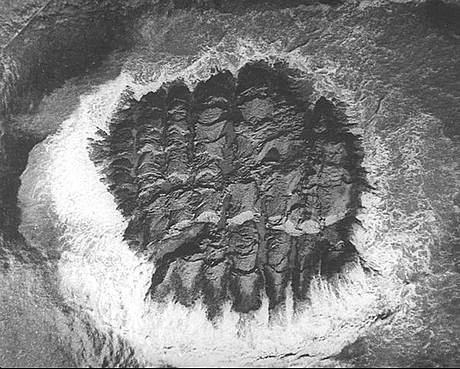
Few previous earthquakes on the Makran coast are documented as well as the 1945 earthquake.
28 November 1945 Makran Mw 8.1 Earthquake An authoritative study on this earthquake has been published by Byrne et al., [1992] and its detailed findings will not be repeated here. This page highlights a problem with the late arrival of the 1945 tsunami and provides links to articles on events purported to occur in 1765 [Walton, 1865], and 1851 [Merewether, 1852]. Though often cited, these key articles report no evidence for great earthquakes on the Makran coast in these years.
According to Byrne et al [1992] rupture in 1945 terminated near the coast or slightly offshore. This follows both from waveform modeling and from a consideration of coastal uplift at Ormara [Snead, 1966; VitaFinzi, 1975]. Until recently an unresolved problem with this earthquake was that although a minor local tsunami was caused by the earthquake, the damaging tsunami occurred 2-3 hours later both near the epicenter and at Karachi [Pendse, 1946; Ambraseys and Melville, 1982]. It is not possible to envisage a reflected wave from Oman that would cause this delay. The Makran submarine telegraph cable was severed in eight places, and four temporary islands were formed attesting to considerable sea-floor changes offshore [Ambraseys & Melville, 1982]. Thus the Makran tsunami that features so prominently in post 2004 hazard discussions was thought to be caused by one or more submarine slumps and not by primary sea floor uplift. The implication is that a tsunami in the region could be generated by a relatively modest earthquake. A tsunami could also be triggered by a marine slide without an earthquake. One such orphan tsunami (a tsunami without a known earthquake) caused consternation among the ships of Vasco da Gama' s fleet in 1524 near Dabul, south of Bombay [Bendick and Bilham, 1999].
A recent study by Neetu et al. (2011), however, concludes that the late arriving tsunami waves were very probably caused by a reflection of the outward bound tsunami at the edge of the continental shelf, where an abrupt decrease in velocity occurs. The reflected waves then travelled to great distances as trapped shelf waves, a phenomenon caused by the continental slope refracting gravity waves in concave paths along the coast of India southward.
The formation of the temporary islands was accompanied by loud sounds, and in one case by the spontaneous combustion of gas followed by a small tsunami onshore. Ambraseys observes that the delicate features of the solid-earth waves and fractured surfaces frozen into the surface of the islands (see picture from Sondhi [1947] below) should have been eroded had the island appeared before the main tsunami. The negligible smoothing effects of waves in this photo, however, and Sondhi's description of the hardness of the materials on their surface suggests that the islands could have preceeded (or accompanied) the tsunami. Sondhi claims the islands to be several hundred meters across. They were eroded in the following year but their presence is now recorded by muddy waters offshore.

This study developed from a workshop held at NED University, Karachi, in January 2007 attended and reported by the authors in the Seism.Res.Lett article below. Partial support for the work came from L’Institute de Physique du Globe de Paris and National Science Foundation Grant No. 0229690. Any opinions, findings, and conclusions or recommendations expressed in this paper are those of the authors and do not necessarily reflect the views of the National Science Foundation.
References